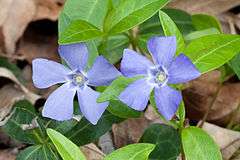Vinca minor
Vinca minor (common names lesser periwinkle[1] or dwarf periwinkle) is a species of flowering plant in the dogbane family, native to central and southern Europe, from Portugal and France north to the Netherlands and the Baltic States, east to the Caucasus, and also southwestern Asia in Turkey. Other vernacular names used in cultivation include small periwinkle, common periwinkle, and sometimes in the United States, myrtle or creeping myrtle.[2]

| Vinca minor | |
|---|---|
 | |
| Scientific classification | |
| Kingdom: | Plantae |
| Clade: | Tracheophytes |
| Clade: | Angiosperms |
| Clade: | Eudicots |
| Clade: | Asterids |
| Order: | Gentianales |
| Family: | Apocynaceae |
| Genus: | Vinca |
| Species: | V. minor |
| Binomial name | |
| Vinca minor | |
Description
Vinca minor is a trailing subshrub, spreading along the ground and rooting along the stems to form large clonal colonies and occasionally scrambling up to 40 centimetres (16 in) high but never twining or climbing. The leaves are evergreen, opposite, 2–4.5 centimetres (0.79–1.77 in) long and 1–2.5 centimetres (0.39–0.98 in) broad, glossy dark green with a leathery texture and an entire margin.
The flowers are solitary in the leaf axils and are produced mainly from early spring to mid summer but with a few flowers still produced into the autumn; they are violet-purple (pale purple or white in some cultivated selections), 2–3 centimetres (0.79–1.18 in) diameter, with a five-lobed corolla. The fruit is a pair of follicles 2.5 centimetres (0.98 in) long, containing numerous seeds.
The closely related species Vinca major is similar, but larger in all parts, and also has relatively broader leaves with a hairy margin.
Cultivation
The species is commonly grown as a groundcover in temperate gardens for its evergreen foliage, spring and summer flowers, ease of culture, and dense habit that smothers most weeds. It was once commonly planted in cemeteries in parts of the Southern United States and naturalized periwinkle may indicate the presence of graves whose other markers have disappeared.[3]
The species has few pests or diseases outside its native range and is widely naturalised and classified as an invasive species in parts of North America. Invasion can be restricted by removal of rooting stems in spring.[4] Once established, it is difficult to eradicate, as its waxy leaves shed most water-based herbicide sprays. Removal involves cutting, followed by immediate application of concentrated glyphosate or triclopyr to the cut stems. Repeated chemical treatments may be necessary, along with digging up the roots where feasible.[5]
Cultivars

There are numerous cultivars, with different flower colours and variegated foliage. Many have a less vigorous habit than the species, and are therefore more suitable for smaller gardens. The following cultivars have gained the Royal Horticultural Society's Award of Garden Merit:-[6]
Medicinal use: chemical constituents
Vinca minor contains more than 50 alkaloids, including vincamine.[11] Other alkaloids include reserpine, reserpinine, akuammicine, majdine, vinerine, ervine, vineridine, tombozine, vincamajine, vincanine, vincanidine,[12] vincamone, apovincamine, vincaminol, desoxyvincaminol,[13] vincorine[14] and perivincine.[15]
Vinpocetine (brand names: Cavinton, Intelectol; chemical name: ethyl apovincaminate) is a semisynthetic derivative alkaloid of vincamine.
Colour
The colour name periwinkle is derived from the flower.
References
- "BSBI List 2007". Botanical Society of Britain and Ireland. Archived from the original (xls) on 2015-01-25. Retrieved 2014-10-17.
- Foster, Rachel. "So Many Myrtles — Unraveling the confusion and contradiction". Archived from the original on April 12, 2008. Retrieved December 2, 2019.
- Hobbs, Holly (2012-11-20). "Preservation group discovers Fairfax County's past as it cleans up graves". Washington Post.
- "Vinca minor". Natural Resources Conservation Service PLANTS Database. USDA. Retrieved August 26, 2006.
- "Vines". NPS. November 11, 2010. Retrieved June 29, 2013.
- "AGM Plants - Ornamental" (PDF). Royal Horticultural Society. July 2017. p. 107. Retrieved 18 February 2019.
- "Vinca minor Argenteovariegata". RHS. Retrieved June 29, 2013.
- "Vinca minor Atropurpurea". RHS. Retrieved June 29, 2013.
- "Vinca minor Azurea Flore Pleno". RHS. Retrieved June 29, 2013.
- "Vinca minor 'Bowles's Variety'". RHS. Retrieved 19 February 2019.
- Khanavi, M.; Pourmoslemi, S.; Farahanikia, B.; Hadjiakhoondi, A.; Ostad, S. N. (2010). "Cytotoxicity ofVinca minor". Pharmaceutical Biology. 48 (1): 96–100. doi:10.3109/13880200903046187. PMID 20645762.
- Tulyaganov, T. S.; Nigmatullaev, A. M. (2000). "Alkaloids of Vinca minor". Chemistry of Natural Compounds. 36 (5): 540. doi:10.1023/A:1002820414086.
- Smeyers, Y. G.; Smeyers, N. J.; Randez, J. J.; Hernandez-Laguna, A.; Galvez-Ruano, E. (1991). "A structural and pharmacological study of alkaloids of Vinca Minor". Molecular Engineering. 1 (2): 153. doi:10.1007/BF00420051.
- Yasui, Y.; Kinugawa, T.; Takemoto, Y. (2009). "Synthetic studies on vincorine: Access to the 3a,8a-dialkyl-1,2,3,3a,8,8a-hexahydropyrrolo\2,3-b]indole skeleton" (PDF). Chemical Communications (28): 4275. doi:10.1039/b907210a.
- Farnsworth, N. R.; Draus, F. J.; Sager, R. W.; Bianculli, J. A. (2006). "Studies on Vinca major L. (Apocynaceae) I. Isolation of perivincine". Journal of the American Pharmaceutical Association. 49 (9): 589. doi:10.1002/jps.3030490908.
Further reading
- Flora Europaea: Vinca minor distribution
- Morphology and ecology of Vinca minor (in Spanish)
- Borealforest: Vinca minor
- Vinca minor (from Ohio State University's Pocket Gardener)
- Common periwinkle (as an invasive species; includes photos)
- Blamey, M., & Grey-Wilson, C. (1989). Flora of Britain and Northern Europe. Hodder & Stoughton.
- Huxley, A., ed. (1992). New RHS Dictionary of Gardening 4: 665. Macmillan.
- detailed technical description
- Encyclopedia of Life database entry
External links
| Wikimedia Commons has media related to Vinca minor. |